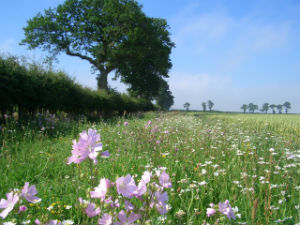Study Finds Unused Farmland Could Be Key to Aiding the Survival of Farmland Birds
06 April 2017

Planting wild flowers at the edges of arable fields could significantly improve the habitat for farmland birds and contribute to their survival, a study has found.
Researchers have been exploring how by making simple changes to land otherwise left untended can have a huge impact on wildlife.
Scientists from the University of Reading were part of a study investigating the effect of three different seed mixes, including the standard grass-only mix, in addressing the decline of birds like yellowhammers, goldfinches and whitethroats across agricultural landscapes.
It was led by Dr Duncan Westbury, a senior ecologist from the University of Worcester, and also involved the Centre for Ecology & Hydrology (CEH).
The study looked at what plant and invertebrate resources, such as beetles, were present in so-called ‘field margins’ – strips of unused land at the edges of crop fields.
It found that if these areas were cultivated and sown with certain plant species, such as knapweed and teasel, the amount of food available to birds was dramatically increased.
'Crucial to many species'
Dr Westbury said: “It is evident that the ability of field margins to support many farmland bird species has been limited due to birds not always being able to find enough food within them.
“This study has shown that simple but effective approaches, such as sowing wild flower seeds, could be crucial to the survival of many species. The barrier to widespread implementation is now to convince policy makers to support such action.”
The research findings were published in the Agriculture, Ecosystems & Environment journal.
The study also recommends that periodically disturbing grass-only areas next to the crop edge, which are more cost-effective, as opposed to annual mowing, can improve their value to birds.
The findings of this study have implications for ecological conservation on farms which are part of national schemes that were devised to address the decline in farmland birds in the UK.
Dr Ben Woodcock, a co-author of the research from CEH, said: “What this study shows is that the quality of habitat created at the edges of arable fields is crucial in terms of the amount of food produced.
“As these field margin habitats are on land that could otherwise be used to grow crops, it is of vital importance that opportunities for birds to use this resource are not wasted, by managing to the highest quality to provide as much bird food as possible.”
Full reference:
D. Westbury, B. Woodcock, S. Harris, V. Brown, S. Potts (2017). 'Buffer strip management to deliver plant and invertibrate resources for farmland birds in agricultural landscapes'. Agriculture, Ecosystems & Environment. doi: 10.1016/j.agee.2017.02.031
Photo credit: Dr Duncan Westbury, University of Worcester
